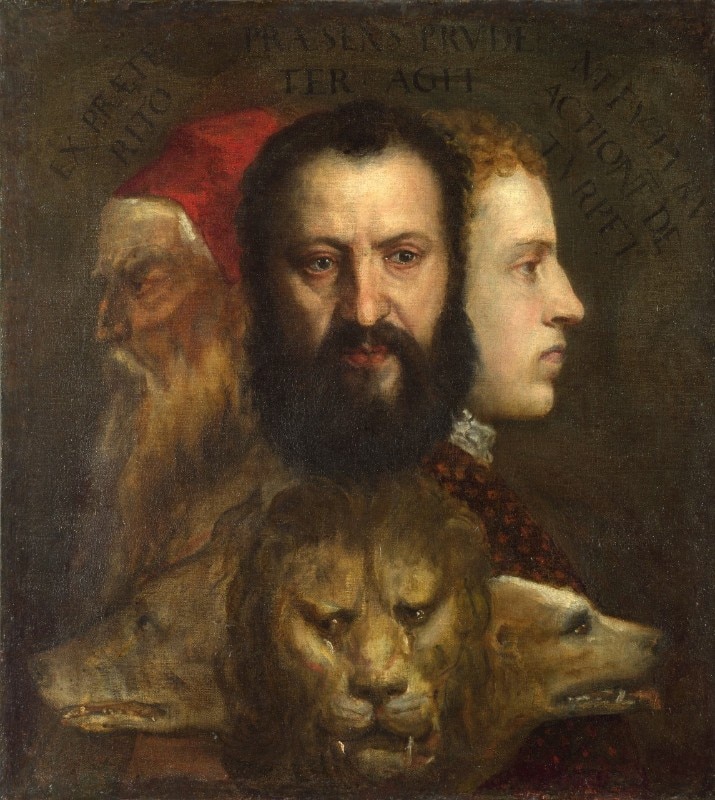A time that is out of joint, almost out of time. Our time. We imagine a world, we build it, but then? Then it’s dull, confused, marked by the same fear that today seems to be measuring the distance. Of our breaths, of our bodies. It resounds through the deserted streets and it forces us to measure the space. That’s when, suddenly, we lose our memory, we lose our past and we cannot find the path that leads us back to our present, as well as the one we had designed - or rather tried to design - to reach our future.
Art teaches. A futurist and visionary master that tells us of a distant past, as well as of a present – our present. There is a Latin inscription that can be translated as: "From the experience of the past / the present acts prudently / lest it spoil future actions." It is found at the top of one of Titian’s best-known works: the Allegory of Time Governed by Prudence, which is a seemingly unfinished painting representing the heads of three animals (from left to right: a wolf, a lion, and a dog) underneath three male heads (an elderly, a middle aged, and a young man). But, before we go on, we need to point out something: in the old language, “prudence” did not have the same meaning as it does today - it meant “wisdom”, “astuteness”, “common sense”. A word that, as a consequence, cannot but be linked to the concept of time: a prudent man, or a wiseman, is someone who learns from their past experiences in order to act cautiously in the present and lay sound foundations for the future.
Three male heads, three portraits: Titian himself can be found in the sharp profile of the old man looking left, or back to his past – which is something in line with the inscription at the top, and is also coherent with the fact that, in Western culture, a text or an image is usually read from left to right. Then, the man at the center might be Titian’s son Orazio: he’s a middle-aged man, with dark hair, beard, and skin. He is looking right in front of him, directly at the viewer. The left side of his face is shaded, but it gets increasingly illuminated – which is a perfect metaphor for the temporary, ever-changing aspect of the present. Finally, there’s Marco, the young man looking right, or forward. He has pale skin, red hair, and a face that is entirely illuminated by a bright future.
A prudent man, or a wiseman, is someone who learns from their past experiences in order to act cautiously in the present and lay sound foundations for the future
Then, for what concerns the three animals’ heads, Titian probably took his inspiration from “The Idea of the Theater” by Giulio Camillo (1480-1544), a great Italian philosopher interested in eloquence, mnemotechnics, divination and alchemy. In his text, Camillo talked about the presence of three beasts inside “the Cave of Saturn”, which corresponded to the three “saturnine times” – the times of intellectual activities, that specific melancholy that swings back and forth between concentration and distraction, productive inspiration and depressive stasis, and which, according to the humanistic theory, goes hand in hand with artistic creation.
Thus, the allegory of this painting does not deal with an ordinary time, but with that of the artist - a special time that must be dealt with according to the scansion of memory, intelligence and foresight, which are the three elements that have contributed to the meaning of Prudence over the course of time. In fact, Titian’s painting can be partially described as an emblem, when analyzing the themes of the three ages of man, the three divisions of time, and the three components of prudence. If time is governed by prudence, then the triple portrait trumps it: it applies all three divisions of time to the figure of the man, who is seen almost as a progenitor, thus witnessing a new dialectical proposal, where the artist shows his awareness for the sense of mutability and of the end.
Only great art can unveil the mystery of life. And only a great painter like Titian could come up with such a great project, capable of combining the invention, construction and execution of the work with a language that is most appropriate to the development and communication of its meaning within such a vibrant cultural fabric. It almost seems that the vision, which is an emblem in itself, is the docile expression of the human thought, and that the works of art are mere reminders for the entire world - and they’re not overshadowed by our ideas and intentions.
Opening image: Titian, Allegory of Prudence, c. 1565-70


